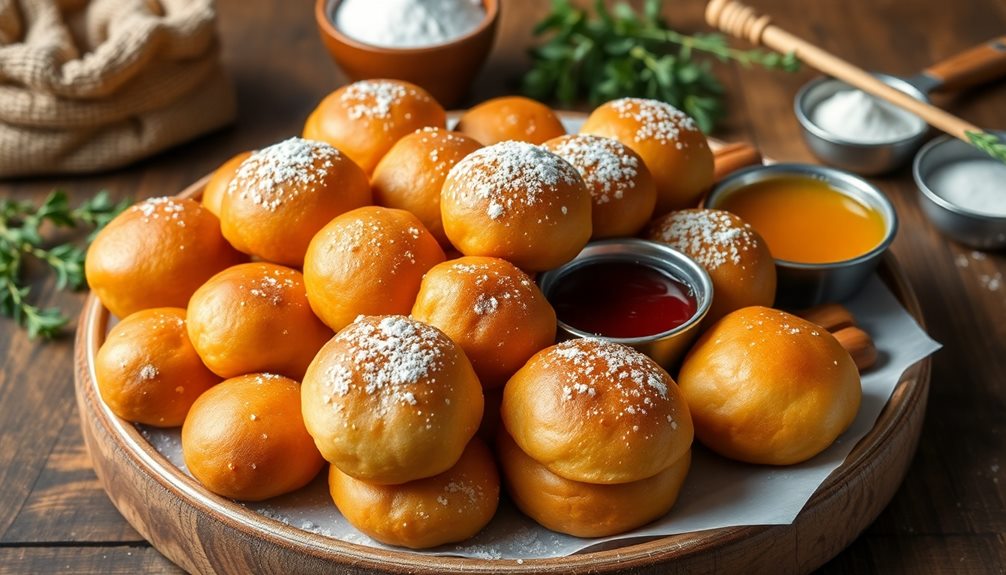To balance the sweetness and acidity in your bobotie, taste the dish as it cooks and adjust with a bit more lemon juice or vinegar if it feels too sweet, or add a pinch more sugar if it’s too tangy. Incorporate dried fruits or raisins to enhance sweetness, and serve with tangy chutneys or pickled vegetables to complement the spicy richness. Keep experimenting with these tweaks, and you’ll create a perfectly balanced bobotie that highlights South Africa’s vibrant flavors.
Key Takeaways
- Incorporate dried fruits or sugar for sweetness, balanced with vinegar or lemon juice for acidity.
- Taste and adjust spices, sugar, and acid during cooking to achieve harmony.
- Use traditional spices like turmeric, cumin, and cinnamon to create a warm, aromatic base.
- Serve with side dishes like chutney or pickled vegetables to enhance sweet and sour flavors.
- Bake until the crust is golden and crispy, allowing flavors to meld and develop a balanced profile.

Have you ever wondered about the vibrant flavors of South Africa? If so, you’re in for a treat with bobotie, a beloved dish that blends savory, sweet, and tangy elements into one harmonious bite. One of the reasons this dish stands out is because of its diverse spice variations. Traditional recipes often include a mix of turmeric, cumin, coriander, and a touch of cinnamon, creating a warm, aromatic base. But depending on your taste, you can experiment with other spices like cardamom or cloves to add depth. This flexibility allows you to tailor the dish to your preferences, making each version uniquely yours. When it comes to traditional serving, bobotie is typically presented with a golden, baked egg topping that forms a crust, giving it a comforting, casserole-like appearance. It’s commonly accompanied by yellow rice flavored with raisins or sultanas, which adds a sweet contrast to the savory meat. A side of chutney or pickled vegetables often complements the dish perfectly, enhancing its sweet and sour profile. The balance of flavors is central to the experience of eating bobotie, especially when you think about how the sweetness from dried fruits or sugar is offset by the acidity of vinegar or lemon juice. This interplay creates a vibrant flavor profile that keeps each bite interesting. The dish’s ability to harmonize curry sweetness with acidity is part of what makes it so appealing. You might find that adjusting the amount of sugar or lemon juice can shift the flavor balance to suit your palate. Additionally, understanding the cultural significance of bobotie can deepen your appreciation for its place in South Africa’s culinary heritage. When preparing bobotie, it’s essential to taste as you go, ensuring that the spices, sweetness, and acidity come together just right. Incorporating spice variations can further customize the dish and introduce new layers of flavor. The dish’s layers of flavor develop as it bakes, with the top forming a slightly crispy crust that adds texture to the soft, flavorful meat underneath. Serving it warm, straight from the oven, allows the flavors to meld beautifully. Overall, bobotie offers a wonderful way to explore South Africa’s culinary heritage, with its perfect blend of spice variations, traditional serving, and a delightful balance of flavors. Understanding the flavor balance involved in this dish can help you customize it to your liking, making each meal a unique experience. Whether you’re cooking for friends or just treating yourself, this dish invites you to enjoy a taste of South African tradition with every flavorful forkful.
Frequently Asked Questions
What Are the Traditional Side Dishes Served With Bobotie?
When serving bobotie, you typically enjoy it with traditional side dishes like yellow rice, which complements the rich flavors. Spiced chutneys add a tangy sweetness that balances the curry’s spice and acidity. You might also include a fresh salad or steamed vegetables for contrast. These sides enhance the dish’s depth, creating a harmonious meal that highlights the savory, sweet, and sour elements in bobotie.
Can Bobotie Be Made Vegetarian or Vegan?
Imagine transforming a classic dish into a vegetarian or vegan masterpiece—yes, you can! With meat substitutes like lentils, mushrooms, or textured vegetable protein, you’ll get the hearty texture you crave. Just remember, flavor adjustments are key; add spices and acidity to mimic the rich, savory taste of traditional meat. So, go ahead—reimagine bobotie, making it plant-based without sacrificing its irresistible charm!
How Long Does It Take to Prepare Authentic Bobotie?
Preparing authentic bobotie typically takes about 1.5 to 2 hours, including cooking time and preparation steps. You start by chopping ingredients, sautéing spices, and simmering the meat or veggie mix. Then, you assemble and bake the dish until golden. This process involves combining flavors thoughtfully to balance curry sweetness with acidity, so give yourself enough time to follow each step carefully for the best results.
Are There Regional Variations of Bobotie in South Africa?
Imagine tasting a symphony where each region adds its unique instrument—that’s regional flavors in bobotie. South Africa’s culinary diversity shines through these variations, from the Cape Malay’s sweet, fragrant spices to the more savory, spicy inland styles. You’ll find differences in ingredients and preparation methods across regions, making each bobotie a reflection of local culture and taste. So, yes, regional variations truly enrich this beloved dish.
What Wine Pairs Best With Bobotie?
When considering wine pairing with bobotie, focus on achieving flavor harmony. A medium-bodied white like Chenin Blanc complements the dish’s sweet and savory notes, while a light red such as Pinot Noir can balance the spices without overpowering. You might also try a slightly off-dry Riesling to enhance the curry’s sweetness. Ultimately, choose a wine that enhances the dish’s complex flavors and creates a delightful contrast.
Conclusion
Just like a well-tuned symphony, your bobotie blends sweet and sour notes to create harmony on the palate. Remember, mastering this dish is like balancing a tightrope—trust your taste buds to guide you, adding a splash of vinegar or a touch of sugar as needed. With patience and intuition, you’ll craft a meal that sings with flavor, inviting everyone to savor the melody of South Africa’s culinary heritage.









